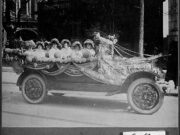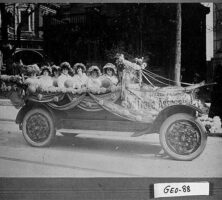Mary Latimer McLendon, along with her older sister Rebecca Latimer Felton, was a leader in the prohibition and woman suffrage movements in Georgia. She is perhaps best known for her long tenure as president of the Georgia Women’s Suffrage Association (GWSA). After her death in 1921, the GWSA and Georgia Women’s Christian Temperance Union (WCTU) placed a marble fountain bearing her likeness in the state capitol; the inscription recognizes her as the “Mother of Suffrage in Georgia.”
Mary Latimer was born in DeKalb County in 1840, the daughter of Eleanor Swift and Charles Latimer. A graduate of the Southern Masonic Female College in Covington, she married Nicholas A. McLendon in 1860 and moved to Atlanta. When Union troops ordered Atlanta evacuated during the Civil War (1861-65), she and her family moved to Crawfordville, returning to Atlanta in 1868.
By the 1880s Mary McLendon had founded one of the Georgia WCTU’s most active chapters, the Francis Willard chapter in Atlanta. McLendon also served the state WCTU in numerous capacities. She headed an effort to secure passage of a state law mandating school instruction about the debilitating effects of alcohol use, and for twenty years she coordinated annual public speaking competitions for students. A lifelong Methodist, she was outraged when Georgia Methodist leaders forbade the state arm of the WCTU to meet in their churches because the national WCTU organization supported woman suffrage. McLendon, in fact, had unsuccessfully lobbied Georgia WCTU members to endorse the vote for women. Despite being rebuffed on the suffrage issue, McLendon remained a mainstay in the state organization, rejoicing in 1907 when Georgia’s legislature approved a state prohibition amendment. In 1918 the state legislature endorsed federal prohibition, ratifying the Eighteenth Amendment of the U.S. Constitution, which prohibited the sale and production of “intoxicating liquors” across the country.
In 1894 Mary McLendon founded the Atlanta chapter of the GWSA, the second local woman suffrage organization to be established in the state. By 1896 she was president of the state organization, serving in that capacity until 1899 and then from 1906 until her death in 1921. Though McLendon initially supported a state, rather than a federal, constitutional amendment to enfranchise women, she eventually came to believe that a federal amendment offered the only possibility of success. McLendon believed that women would use their votes to pass a comprehensive reform program, including abolishing child labor, raising the age of consent for girls, instituting compulsory school attendance, and hiring female guards for the state’s female prisoners.

Courtesy of Georgia Archives.
Though often opposed to the tactics of rival suffrage organizations in the state, McLendon led the GWSA to join with them to sponsor parades and distribute leaflets on behalf of the cause. Beginning in 1913, she wrote a series of newspaper columns in support of woman suffrage and other reforms. After years of GWSA campaigning, Atlanta permitted municipal woman suffrage in 1919. In that same year the U.S. Congress approved the Nineteenth Amendment to the U.S. Constitution, granting women the right to vote. Despite the Georgia legislature’s opposition, the amendment was ratified in August 1920. State authorities, however, refused to let women vote in the November elections because they had not registered by the spring deadline. McLendon spent the last year of her life working to ensure that the state of Georgia recognized women’s right to vote.
Mary McLendon died November 20, 1921, survived by a daughter, Nellie Henderson, and a grandson.





